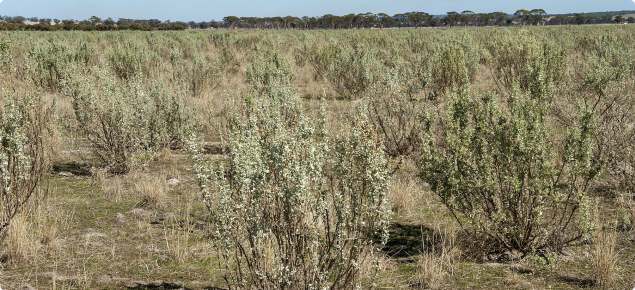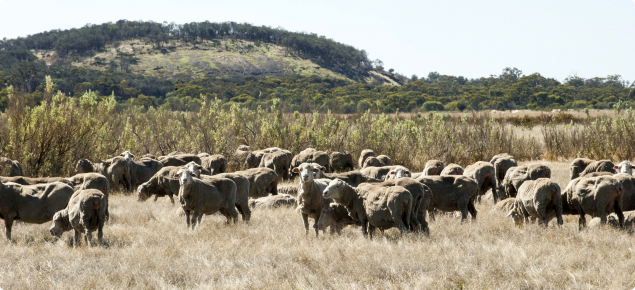Saltbush, salt and livestock
Saltbush-based pastures have been widely adopted to deal with saline land, the autumn feed gap and seasonal drought in Australia and many other countries around the world (Ben Salem et al. 2010). While these plants provide out of season forage and survive in low rainfall environments, they also contain minerals and secondary compounds in concentrations much higher than in traditional and non-halophytic pasture plants.
The commonly used saltbush species may contain 18–30% ash, with most of this being sodium (Na, up to 8%), chlorine (Cl, up to 12%) or potassium (K, up to 6%) (Ben Salem et al. 2010). Research has shown that at concentrations of Na above 5%, feed intake is depressed, with intake being further lowered by high K (Masters et al. 2005). Sheep and cattle can only manage a high salt intake from halophytes with the right amount and quality of water to flush excess salts.
When saltbush is the only dietary component, drinking water has to be very fresh to maintain feed intake. Under commercial conditions, saltbush is rarely the only source of feed, and will usually make up 13– 50% of the diet, with understory or stubbles making up the rest (Norman et al. 2010). Under these conditions, some salt in drinking water may be tolerable and safe – see the scenarios below.
Drinking water requirements change during the year
Livestock drinking requirements are highest in hot dry conditions, and where salt intake is high. In the Western Australian winter, which is cool and wet, drinking requirements are at their lowest level.
Changing the water supply
Rapid changes of water supply from fresh to salty, or from salty to fresh, can damage livestock health. We recommend that every water source is tested before supplying it to livestock, and management of that water supply to livestock is adapted based on the salt level. Consult a veterinarian or livestock consultant about changes of water supply.
In the calculations below, we have not allowed for moisture content in the feed, or for wet feed during winter. We have done this deliberately, so that the water supply is designed for the driest time of year when demand is highest. This provides the animal welfare safety factor needed when grazing halophytes.
For more information on drinking water requirements for different classes of livestock, see:
- Water quality for livestock
- Livestock water requirements and water budgeting for south-west Western Australia.
Estimating water salinity – guidelines for sheep and cattle consuming saltbush
The guidelines for livestock drinking water salinity need to be adjusted to account for increased salt in saltland pastures. This can be done in two ways:
- Combine the salt consumed in saltbush with the salt in the water supply.
- Estimate the water required for salt clearance.
The best way to demonstrate this is through a description of scenarios. In these scenarios:
- All sheep are assumed to be 30–50 kg, non-pregnant and non-lactating, and the total feed intake is limited to 1000 grams of dry matter per day (gDM/day). Saltbush is assumed to have 25% soluble salt (NaCl).
- All cattle are assumed to be 450 kg, non-pregnant, non-lactating, and the total feed intake is limited to 8000 gDM/day. Note that the detailed calculations have not been provided for cattle. Contact us if you want that information added.
Method 1 – Combining the salt consumed in saltbush and the water supply
Even though water and feed are consumed separately, they are quickly combined in the rumen. The soluble salt in the consumed saltbush and water can be considered as one source.
Scenario 1; 30% saltbush in the sheep diet with 6 L/day of fresh water
- Total feed intake – 1000 g/day
- Saltbush intake – 300 g/day
- Salt intake – 75 g/day (assuming 25% NaCl in the saltbush)
- Estimated fresh water intake – 6 L/day (no salt)
Assuming all salt is soluble and dissolved in the fresh water consumed, the effective salinity of the water consumed is 12 500 mg/L. This exceeds the maximum tolerable concentration (category C) in the guidelines for most livestock species and classes. Others have reported that consumption of water containing 1.3–1.5% NaCl (13 000 mg/L) increases ruminal osmotic pressure and reduces microbial population (Potter et al. 1972) but may not decrease feed intake (Wilson and Dudzinski 1973). The recognised Australian authority on nutrient requirements for domesticated ruminants indicates, from various studies, that Merino sheep can tolerate 1.3% NaCl for long periods if gradually introduced to that level (Freer et al. 2007).
Scenario 2 - 30% saltbush in the sheep diet with 12 L/day of fresh water
- Total feed intake – 1000 g/day
- Saltbush intake – 300 g/day
- Salt intake – 75 g/day (assuming 25% NaCl in the saltbush)
- Estimated fresh water intake – 12 L/day (no salt)
Assuming all salt is soluble and dissolved in the fresh water intake, the effective salinity of the water consumed is 6250 mg/L. This is consistent with upper level of the guidelines in category B – some adaption required but little production loss.
Recommendation
The combined results of this calculation method indicate that, to be consistent with the conservative values in the current guidelines, you should provide at least 10 L/day of fresh water where saltbush is 30% of the diet.
Method 2 – Estimate the water required for salt clearance
Sheep and cattle cannot store excess salt, it is excreted in urine. The ability to manage high salt in feed and water is then dependent on the ability of the animal to concentrate salt in urine and excrete it. Merinos are able to concentrate urine so that it contains approximately 3% NaCl, this means that they require approximately 30 ml water to excrete each g of NaCl (Freer et al. 2007).
In addition to this 30 ml water for each g of salt, growing and non-pregnant adult sheep would normally require approximately 2 L water/kg DM consumed at mild temperature (15–20°C) for metabolism and respiratory evaporation (Freer et al. 2007).
As with Method 1, all sheep are assumed to be 30–50 kg, non-pregnant and non-lactating and consuming a maximum of 1000 g/day. We also assume they require 2 L water/kg DM intake in addition to the water required to excrete salt.
Scenario 3 - 30% saltbush in the sheep diet with fresh water
- Total feed intake – 1000 g/day
- Saltbush intake – 300 g/day
- Salt intake – 75 g/day (assuming 25% NaCl in the saltbush)
- Fresh water requirement to excrete salt = 2.3 L/day (75 x 30)
- Total fresh water requirement = 4.3 L/day (2.5 + 2)
Theoretically, this is a physiologically manageable scenario for the sheep: they would normally drink between 2 and 6 L/day, depending on ambient temperature and physiological state. Under experimental conditions, sheep consuming a similar amount of salt in the diet have been reported to drink 6–7 L/day (Masters et al. 2005).
Scenario 4 – 30% saltbush in the sheep diet with water at the upper limit of the 'no adverse effects' guideline (4 g NaCl/L)
- Total feed intake – 1000 g/day
- Saltbush intake – 300 g/day
- Salt intake from saltbush – 75 g/day (assuming 25% NaCl in the saltbush)
- Salt intake from water (assumed water intake of 5 L/day) – 20 g/day
- Total salt intake = 95 g/day (75 + 20)
- Water required to excrete salt = 2.8 L/day (95 x 30)
- Total water required = 4.8 L/day (2.8 + 2)
In this scenario, the sheep are consuming just enough water to clear all the salt, although the animals may need to drink more. This is probably manageable with some adaptation.
Scenario 5 – 50% saltbush in the diet at the upper limit of the 'should adapt without loss of production' guideline (10 g NaCl/L)
- Total feed intake – 1000 g/day
- Saltbush intake – 500 g/day
- Salt intake from saltbush – 125 g/day (assuming 25% NaCl in the saltbush)
- Salt intake from water (assumed water intake of 5 L/day) – 50 g/day
- Total salt intake = 175 g/day (125+ 50)
- Water required to excrete salt = 5.25 L/day (175 x 30)
- Total water required = 7.25 L/day (5.25 + 2)
In this scenario the sheep are not consuming enough water to clear the salt and would need to drink more. By drinking more they further increase the salt load. This scenario is a high risk.
Calculations based on physiology (Method 2) indicate a higher tolerance of salt in water than in Method 1 but has less field validation. Using Method 2 indicates that there are unlikely to be adverse effects with non-reproducing sheep drinking water with 0–2000 mg NaCl/L and that adaptation may be possible between 2000–4000 mg NaCl/L. Above 4000 mg NaCl/L would be a high risk.
Late-pregnant and lactating ewes have a much higher water requirement for metabolism and milk production, with a lower proportion of water drunk available for urinary excretion. Salt intake guidelines for these animals would need to be decreased by a further 50%.
Cattle urine is usually less concentrated than sheep and they may require 60 ml water per g NaCl (Freer et al. 2007). This would indicate salt intake guidelines for cattle should also be 50% lower than guidelines for non-reproducing sheep.
Overall interpretation
- To be consistent with the current conservative guidelines, Method 1 would need to be adopted. That is, supply at least 10 L/day of fresh water for sheep consuming more than 30% of their diet as saltbush. The guideline for cattle would be similar.
- Using a physiological method to estimate salinity tolerance indicates no adverse affects are likely for non-reproducing sheep with water from 0–2000 mg/L, adaptation may be possible up to 4000 mg/L with loss of production when concentration is above 4000 mg/L. Water for cattle and reproducing sheep should contain half these salt concentrations.
Limitations
- Risks will be increased during periods of high ambient temperature if the supply of water is limited or if the water supply requires a long travel time.
- The calculations made are based on saltbush having a salt content of 25% and making up 30–50% of the diet.
- All calculations are based on salt intake being primarily NaCl.
- It is assumed all water is supplied and none obtained from forage consumption.
Acknowledgement
The research and scenarios on this page were done by Dr David Masters, Livestock Systems Scientist, to support the Saltland Genie App project.
Bibliography
Ben Salem H, Norman HC, Nefzaoui A, Mayberry DE, Pearce KL, Revell DK (2010) 'Potential use of oldman saltbush (Atriplex nummularia Lindl.) in sheep and goat feeding', Small Ruminant Research, 91:13–28.
Freer M, Dove H, Nolan JV (eds) (2007) Nutrient requirements of domesticated ruminants, (CSIRO Publications: East Melbourne)
Masters DG, Rintoul AJ, Dynes RA, Pearce KL, Norman HC (2005) 'Feed intake and production in sheep fed diets high in sodium and potassium', Australian Journal of Agricultural Research, 56:427–434.
Norman HC, Wilmot MG, Thomas DT, Barrett-Lennard EG, Masters DG (2010) 'Sheep production, plant growth and nutritive value of a saltbush-based pasture system subject to rotational grazing or set stocking', Small Ruminant Research, 91:103–109.
Potter BJ, Walker DJ, Forrest WW (1972) 'Changes in intraruminal function of sheep when drinking saline water', British Journal Nutrition, 27:75–83.
Wilson A, Dudzinski M (1973) 'Influence of the concentration and volume of saline water on the food intake of sheep, and on their excretion of sodium and water in urine and faeces', Australian Journal of Agricultural Research, 24:245–256.


